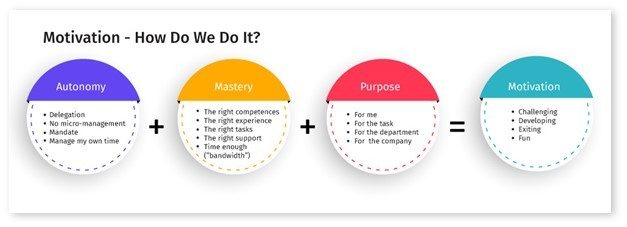
Why Should You Invest In Self-Directed Learning (SDL)?
There is a multitude of reasons why employers should seriously consider investing in self-directed learning. However, the front-runners for why SDL is a must-have strategy include the following.
1. Learner Perspective
Today, learners wish to be more autonomous in when, what, where, and how they learn. A recent LinkedIn Workplace Learning Report concluded that more than 40% of gen Z, and a similar percentage of millennial employees, preferred self-directed workplace learning. For gen X and boomers, that percentage was 33%. As work shifts from the “work primarily at the office” model to the “work from anywhere” (a.k.a. “work from home,” WFH) paradigm, hybrid learners can only succeed in a self-directed learning environment. That’s because, like self-regulated hybrid working—where employees regulate their own work schedules based on organizational priorities—SDL empowers learners to set their own learning goals and craft a logical path to accomplish them.
2. L&D Team Perspective
With training budgets under constant review, L&D teams are continually looking to bring value-add to their services. SDL is a way for training teams to move away from mundane, micromanaging learning while enabling them to focus on vision, strategy, and learning effectiveness.
3. Organizational Perspective
Self-directed learning is imperative in the new hybrid workplace. To respond to dynamically changing business environments, businesses need a learning strategy focused on continuous learning and rapid and effective reskilling or upskilling. SDL delivers that objective.
In the new hybrid work paradigm, employers should not underestimate the importance of learner autonomy. Because employees embracing the WFH model are now more self-reliant in when and how they work, they expect similar levels of flexibility in workplace learning. In delivering those objectives, self-directed Learning increases motivation, improves performance, and fosters talent retention.
And there’s science behind why employers must invest in SDL too. The payback for making such an investment may be summed up in one word: motivation. Human motivation expert Daniel Pink advances a theory highlighting three aspects of motivation; autonomy, mastery, and purpose, which workplace SDL programs could potentially leverage.

Inspiration: Daniel Pink, Drive The Surprising Truth About What Motivates Us & Lars Kollind, Jacob Bøtter, Unboss
There are several strategies of self-directed learning that cement it as a learning modality that delivers all three of those motivational aspects. It does so by:
- Giving learners the freedom (autonomy) to choose their own learning paths.
- Promising the reward of enhanced performance (mastery) at the end of that path.
- Empowering them with a sense of satisfaction and accomplishment (purpose) once they apply that learning and excel at what they do.
Unlike strictly regulated learning, self-directed learning delivers on all three aspects of Pink’s motivational model.
What Is The Value Of Self-Directed Learning?
The new hybrid work environment changes many of the traditional employer-employee dynamics. Because work—and, by extension, work-related learning—occurs in a decentralized (off-premises, remote, virtual) setting today, SDL offers a multi-value proposition for learners, L&D teams, and businesses.
Value For The Learners
- It empowers learners with a greater sense of autonomy and control over their learning.
- Self-directed learning adds more flexibility to the learner’s learning and work style. They can now decide what they wish to learn and when, where, and how they learn.
- Because learners “take charge” of their own learning “destiny,” there’s greater learner-centricity and more learner-focused relevance in the learning.
- By facilitating learning by choice—as opposed to regulated or mandated learning—it delegates ownership (and responsibility) of learning to the learner.
Depending on the models and strategies of self-directed learning that businesses embrace, SDL typically delivers better learning experiences, which result in more fulfilling learning for learners. At the end of the day, a more knowledgeable learner is a more productive employee!
Value For L&D Teams
- By empowering learners with greater autonomy and ownership of their learning, SDL acts as a value-add catalyst for enterprise L&D teams. The time saved on performing time-consuming learning management and monitoring is now used to evaluate learner feedback and in efforts that deliver better learning experiences.
Value For The Business
- By driving learner autonomy, SDL lets HR and L&D teams focus on creating long-term enterprise value through learning strategy and vision. It does so by relieving them from the mundane and time-consuming task of micromanaging learning milestones.
- Self-directed learning encourages a culture of continuous learning across the business.
- SDL motivates individuals and teams to continually strive to specialize in what they do through deeper learning and discovery. This spurs a healthy organization-wide cycle of constant reskilling and upskilling.
- A trained and knowledgeable workforce is good for all stakeholders—individual learners, teams, and the business. As a result, SDL is the catalyst that improves business-wide performance.
By strategically emulating successful strategies of self-directed learning, businesses ensure better learning outcomes from their investment dollars. This leads to better ROI from SDL programs.
How Do You Empower Your Learners With Self-Directed Learning?
A successful organizational SDL program requires implementing a multi-part strategy.
Part 1: Get The Basics Right
Successful SDL depends on three pillars that provide a strong foundation for all other elements of the strategy:
- Understanding today’s learners’ needs and preferences
As the previously referenced LinkedIn survey indicates, unlike the homogenous learning environment of the past, today’s learners have different learning needs and preferences. Ignore those needs at your peril! - Choosing the right enabling tools and technologies to support today’s learner needs
In today’s hybrid work environment, learning technology plays a critical role in determining the success of any self-directed learning initiatives. In fact, choose this building block incorrectly, and your entire SDL strategy may collapse! - Building learning environments that motivate, support, and empower learners to embrace SDL
Appropriate learning content, delivery modes, learning technology, and user support all form a part of an organizational Learning and Performance (L&P) ecosystem. A well-integrated L&P ecosystem is essential for a successful SDL program.
Part 2: Provide For Learning, Practice, And Ongoing Performance Support
- With the basics in place, it’s critical to focus on creating opportunities where learning can take place, and which provide a safe place for learners to practice what they’ve learned and receive ongoing performance support. Strategies of self-directed learning support include job aids, learning in the flow of work (LIFOW) support, and performance support tools.
- Organizations must also invest in immersive learning content, including practice 3D-simulation environments, branching scenarios, Virtual Reality (VR) content, how-to videos, templates, and interactive guides. These help learners acquire new knowledge and apply that knowledge.
Part 3: Checkpoint For Feedback And Evaluation
- Blended learning/social learning for coaching and mentoring
In a virtual workplace like we have today, it’s important to establish multiple checkpoints along a learner’s SDL path. The use of virtual and blended training options is a great way to engage self-directed learners to receive and provide feedback. Organizations can also leverage social learning to deliver coaching and mentoring experiences to hybrid employees. - Provide feedback to steer learners in the right direction
Sound strategies of self-directed learning feedback mechanisms include using tactics such as polling, surveying, data analysis, and other feedback loops to measure and assess the effectiveness of learning and performance ecosystems. Appropriate suggestions, recommendations, and additional/alternative learning pathways can then steer learners toward desired learning goals.
7 Strategies To Drive Self-Directed Learning
There is no one-size-fits-all strategy for implementing a successful organization-wide SDL program. Businesses must customize their strategies according to organizational culture and tailor their strategy for the best fit. However, here are some strategies of self-directed learning that you should consider:
1. Content Curation
Rather than casting a broad net of content, consider the use of AI-enabled tools to make learning recommendations, and for content curation.
2. Digital Learning Assistants
Use chatbots, voice bots, and Machine Learning digital assistants to nudge, remind, and steer learners on their path to self-directed learning.
3. Learning Awareness
Use targeted and timed mailer notices, info sessions, and push notifications—including email, text, and IM—to publicize learning opportunities.
4. Communities And Forums
Create online forums and communities (both moderated and self-moderated) of learners to share experiences, exchange ideas, and propose learning pathways to members.
5. Learning Portals
Establish an online (cloud-based) learning portal where learners may access relevant, curated, and up-to-date content and learning resources 24/7. It’s essential to continuously enhance and refresh the portal so learners keep coming back for more.
6. Enriched Content
In addition to internal content, use a wide variety of other third-party resources to deliver high-quality learning experiences. Some strategies of self-directed learning content resources include YouTube, TEDx, HBR, and popular microblogging sites related to your specific industry.
7. Learner-Driven Approach
Leverage social media platforms, such as Facebook, Instagram, and LinkedIn, as part of your SDL strategy. This approach must also include member-organized/hosted learning events and encouraging learner-generated content to stimulate peer-learning opportunities.
The best SDL programs are ones that learners across the organization fully embrace. And for that to happen, your approach to self-directed learning must include constant encouragement and rewards for those who make use of your SDL investment.
Parting Thoughts
Traditional Instructor-Led Training or self-regulated (mandated by organizations but managed by individual learners) learning models fall short in today’s hybrid work environment. Today, self-directed learning—where learners chart, discover, and fulfill their own learning destiny—is the best approach to learning effectiveness. It delivers real-world benefits to learners, L&D teams, and businesses at every level.
I hope the strategies discussed in this article will help you design and implement your own SDL programs.
Meanwhile, if you have any specific queries, do contact me or leave a comment below.
